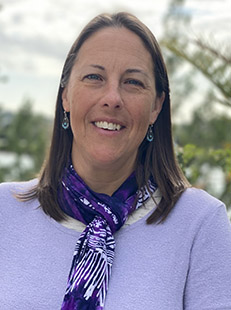Dr. Sheryl Murdock

Sheryl is a deep-sea microbial ecologist whose research focuses on understanding the roles microbes play in biogeochemical cycles and how they contribute to the functioning of the ecosystems in which they live. Her work deals primarily with life in extreme environments such as hydrothermal vents and oxygen minimum zones. She uses molecular tools like DNA barcoding and metagenomics to understand the diversity and functional capacity of microbes and identify potentially important interspecies interactions with larger organisms. She also uses isotope geochemistry to measure various rates for processes within the nitrogen cycle.
Sheryl completed her BSc in biological oceanography at the University of Washington (UW) in 1998. During her undergraduate studies, she worked as a part-time lab technician measuring bacterial production rates in the Columbia River Estuary. After completing her BSc, she spent 16 years as a full-time lab technician/manager, first at UW (1998-2006) and then the University of Victoria (UVic, 2006-2014), working on hydrothermal vent microbial ecology and isotope geochemistry. In 2014 she decided to pursue a doctoral degree at UVic, which she completed in 2021. Before coming to BIOS, she stayed on for a one-year postdoc at UVic to help launch a phytoplankton metabarcode sequencing project as part of the Oceans of Biodiversity Initiative.
Research interests:
Microbial ecology, metagenomics, species interactions, ecosystem function, microbial eukaryotes and parasitism.
Educational Background:
University of Victoria, Victoria, Canada (2021)
- PhD Earth & Ocean Sciences
University of Washington, Seattle, USA (1998)
- BSc Biological Oceanography
Further Information
CV
Selected publications
Murdock SA, Tunnicliffe V, Boschen-Rose RE, & SK Juniper (2021). Emergent ‘core communities’ of microbes, meiofauna and macrofauna in hydrothermal vents. ISME Communications. ISME Communications 1:27.
Orcutt B, Bradley JA, Brazelton WJ, Estes ER, Goordial JM, Huber JA, Jones RM, MahmoudiN, Marlow JJ, Murdock S and M Pachiadaki (2020). Impacts of deep-sea mining on microbial ecosystem services. Limnology & Oceanography 65(7):1489-1510.
Murdock S and SK Juniper (2019). Hydrothermal vent protistan distribution along the Mariana Arc suggests vent endemics may be rare and novel. Environmental Microbiology 21(10):3796-3815.
Crump BC, Fine LM, Fortunato CS, Herfort L, Needoba JA, Murdock SA & FG Prahl (2017).Quantity and quality of particulate organic matter controls bacterial production in the Columbia River estuary. Limnology & Oceanography 62:2713-2731.
Murdock S and SK Juniper (2017). Capturing compositional variation in denitrifying communities: A multiple primer approach that includes Epsilonproteobacteria. Applied and Environmental Microbiology. 83:e02753-16.
Bourbonnais A, Juniper SK, Butterfield DA, Devol AH, Kuypers MMM, Lavik G, Hallam SJ, Wenk CB, Chang BX, Murdock SA, and MF Lehmann (2012). Activity and abundance of denitrifying bacteria in the subsurface biosphere of diffuse hydrothermal vents of the Juan de Fuca Ridge. Biogeosciences 9:1-18.
Murdock S, Johnson H, Forget N, and SK Juniper (2010). Composition and diversity of microbial mats at shallow hydrothermal vents on Volcano 1, South Tonga Arc. Cah. Biol. Mar. 51:407-413.
Forget, N.L, Murdock, S.A, and S.K. Juniper (2010). Bacterial diversity in Fe-rich hydrothermal sediments at two South Tonga Arc submarine volcanoes. Geobiology 8:417-432.
